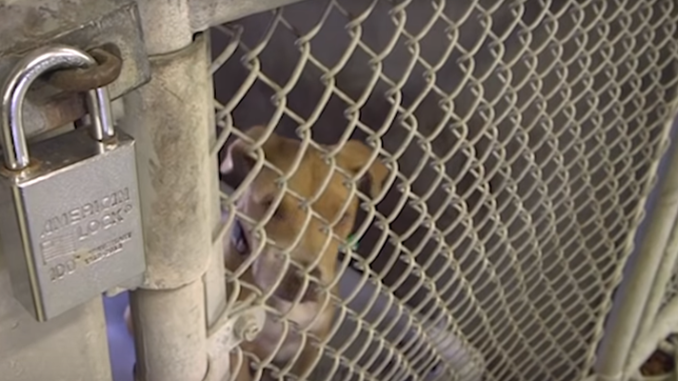
By Serena O’Sullivan, Oskar Agredano, Sydnee Schwartz and Penelope Price
PHOENIX – Head-high stacks of dog beds line the hallways, while row upon row of shelves in storage are packed with pet food.
The barking quickly becomes deafening as hundreds of dogs, one after the other, join the cacophony, the sounds bouncing off the gray concrete walls and the steel kennels that are now their home.
“It’s just overwhelming, they never stop coming. The only thing familiar is there are people here, they get food here, but it is completely confusing to them,” said Suzanne Fuqua, who specializes in animal behavior at the shelter.
It’s a place where just three years ago, anywhere from 80 to 100 animals were being euthanized every day.
“Right now, we’re teetering right around the 900 mark as far as (the total number of) animals are concerned,” said Jose Santiago, the public information officer for the West Maricopa County Animal Care & Control facility, north of Buckeye Road and 27th Avenue.
“We’ve seen upwards of 1,000, 1,100. I remember when I started, we had 1,200 at one point. That’s not something that we want or can do.”
However, the need to find housing and care for these animals is so enormous, shelter employees find ways to make room for them, even though this location has a capacity of only about 400 animals.
Greg Dunaway, who is a board member of the Arizona Animal Rescue Mission, points a finger at the lucrative business of selling puppies as one of the main causes for shelter overcrowding.
“The breeding in Maricopa County is disgusting,” he said angrily. “We see the parent animals dumped here when the breeders are done with them. Just dumped like trash. They have dogs in the backyard and they’re just baby factories,” Santiago added. “That’s just adding to the overpopulation in the area.”
It costs $16 million to run the West Maricopa Animal & Care shelter every year, yet the government-run agency receives only $750,000 in taxpayer money. The rest is provided by other rescue organizations and companies they work with, which provide crucial support. These include PetSmart, PetCo and Safeway.
“When we’re in a situation like the one we’re in right now, we’ll reach out to some of our partners in the area and tell them, ‘We need help,” Santiago said.
That’s when such groups as the Arizona Animal Rescue Mission step in.
“What we ended up doing is, we said, we’re going to take our resources, our money, our time and try and help out the county shelters,” Dunaway said. “You have an intake of over 30,000 animals a year, the county shelter is going to need all the help they can get.”
One way the shelter helps these animals is by making the setting as comfortable as possible.
At the West Maricopa shelter, Fuqua is in charge of making that happen.
“We do assessments of the dogs as best we can to see what we see right today, and then we try to help them be OK here,” she said. “It’s just a very difficult place for them, so we try to do things to help them cope.”
Fuqua, who has been doing behavior work with animals on and off since 1995, said she feels shelter employees have done a good job of keeping most dogs adoptable while they’re at the shelter.
“We give them treats. We give them things to chew on,” she said. “We have something called speed dating, which is they get out of their kennels to visit with a person. Some people can do walks, when the weather is not dreadfully hot. We do playgroups.”
It’s this kind of attention to the animals that has helped Maricopa County Animal Care & Control put fewer dogs to sleep than in past years. It also helps that the Arizona Animal Rescue Mission and similar groups get as many dogs adopted as possible.
The rescue mission has donated thousands of dollars to the shelter while also focusing on public education, particularly about the positives of adopting breeds that often get overlooked.
“We want to sponsor the dogs that don’t get a lot of attention,” Dunaway said. “We want the big dogs, the dogs that have been here a while. We want people to know that those dogs are wonderful dogs, too.”
Some examples include pit bull terrier and Labrador mixes, which make up a large number of the dogs ready for adoption on the Maricopa County Animal Care & Control website/a>.
Dunaway and Santiago agreed that without the kind of partnerships that exist between the government shelters and other local organizations, the number of dogs that would have to be put down would be much bigger.
“One of the biggest accomplishments that we can tout is that almost 40,000 dogs come in and 95 percent of them find homes,” Santiago said. “That’s almost unheard of in a government-run type of shelter. In order to be considered a ‘no kill shelter,’ you have to be at 80 percent, and we’ve been at 95 percent for almost two years.”
Despite these improvements, said Dunaway, who also volunteers at the shelter, much more can be done to help save the animals that continue to arrive every day.
“Maricopa County has the opportunity to set the standard for the rest of the United States in terms of being a turnaround story. We’re already on the way there, we’re already on the way there,” he said.
“The questions is, how quickly will we turn around the story? It’s up to us as a community to decide.”
